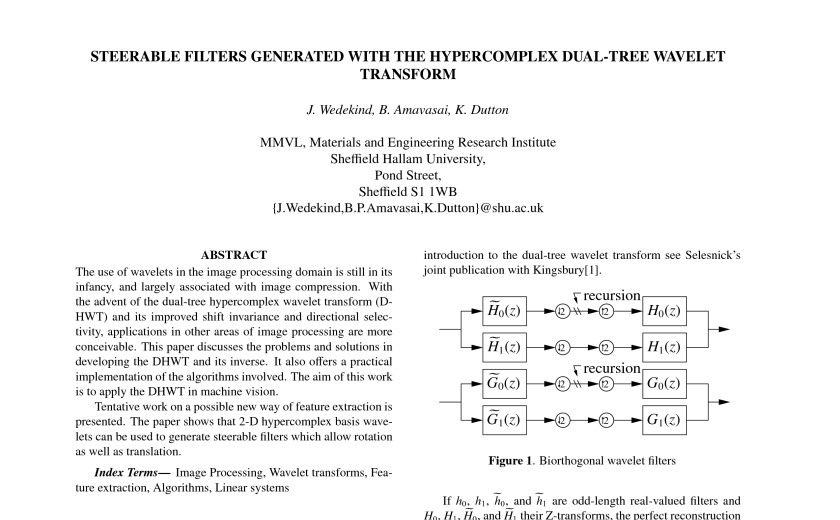Hypercomplex Wavelets
m (→External Links) |
(Link to Fauqeur's keypoint detection paper) |
||
| Line 31: | Line 31: | ||
* [http://www-sigproc.eng.cam.ac.uk/~ngk/ Nick Kingsbury's homepage] | * [http://www-sigproc.eng.cam.ac.uk/~ngk/ Nick Kingsbury's homepage] | ||
** N G Kingsbury: [http://www-sigproc.eng.cam.ac.uk/~ngk/publications/ngk_ACHApap.pdf Complex wavelets for shift invariant analysis and filtering of signals], Journal of Applied and Computational Harmonic Analysis, vol 10, no 3, May 2001 | ** N G Kingsbury: [http://www-sigproc.eng.cam.ac.uk/~ngk/publications/ngk_ACHApap.pdf Complex wavelets for shift invariant analysis and filtering of signals], Journal of Applied and Computational Harmonic Analysis, vol 10, no 3, May 2001 | ||
| + | ** J Fauqueur, N Kingsbury and R Anderson: [http://www-sigproc.eng.cam.ac.uk/~ngk/publications/fauqueur_icip06.pdf Multiscale keypoint detection using the dual-tree complex wavelet transform], Proc. IEEE Conference on Image Processing, Atlanta, GA, 8-11 Oct 2006 | ||
* Thomas Bülow: [http://www.ks.informatik.uni-kiel.de/~vision/doc/Dissertationen/Thomas_Buelow/diss.ps.gz Hypercomplex Spectral Signal Representations for Image Processing and Analysis], PhD thesis, 1999 | * Thomas Bülow: [http://www.ks.informatik.uni-kiel.de/~vision/doc/Dissertationen/Thomas_Buelow/diss.ps.gz Hypercomplex Spectral Signal Representations for Image Processing and Analysis], PhD thesis, 1999 | ||
* [http://home.comcast.net/~cmdaven/hyprcplx.htm Clyde Davenport's page on commutative hypercomplex mathematics] | * [http://home.comcast.net/~cmdaven/hyprcplx.htm Clyde Davenport's page on commutative hypercomplex mathematics] | ||
Revision as of 14:06, 12 December 2007
Contents |
Introduction
Complex wavelets are superior to real-valued wavelets because they are nearly shift-invariant. Complex wavelets yield amplitude-phase information in a similar way as the Fourier transform does. In contrast to the Fourier transform, wavelets allow to analyse the signal locally and thus can be applied to signals with a non-stationary statistic (such as images of a natural scene). In the same way as a one-dimensional signal requires complex numbers to represent the local structure of the signal, two-dimensional signals require hypercomplex numbers. Kingsbury has developed the Dual-Tree Complex Wavelet Transform which allows to recursively compute complex wavelet transforms. Analogous to one-dimensional analysis requiring complex values, two-dimensional analysis requires 4-valued complex numbers (hypercomplex values). Bülow, Kingsbury, and others already have successfully used hypercomplex numbers for analysing two-dimensional signals.
Implementation
HornetsEye now contains an implementation of the Dual-Tree Complex Wavelet Transform. The implementation makes use of Hilbert transform pairs of wavelet bases. The wavelet transform makes use of HornetsEye's MultiArray class. Have a look at the hypercomplex wavelet example for more information.
Wavelet Editor
An editor for visualising linear combinations of wavelets was implemented. The code requires qt4-qtruby, and HornetsEye. Here is the source code:
- Ruby program: waveletEdit.rb
- Qt4 design: waveletEdit.ui
You need to compile the design file using rbuic4 like this:
rbuic4 waveletEdit.ui > ui_waveletEdit.rb
See Also
External Links
- Ivan Selesnick's homepage
- Nick Kingsbury's homepage
- N G Kingsbury: Complex wavelets for shift invariant analysis and filtering of signals, Journal of Applied and Computational Harmonic Analysis, vol 10, no 3, May 2001
- J Fauqueur, N Kingsbury and R Anderson: Multiscale keypoint detection using the dual-tree complex wavelet transform, Proc. IEEE Conference on Image Processing, Atlanta, GA, 8-11 Oct 2006
- Thomas Bülow: Hypercomplex Spectral Signal Representations for Image Processing and Analysis, PhD thesis, 1999
- Clyde Davenport's page on commutative hypercomplex mathematics
- J. Wedekind, B. Amavasai, K. Dutton: Steerable Filters Generated With The Hypercomplex Dual-Tree Wavelet Transform (to be published in ICSPC07 proceedings, also see foils (PDF)) (
 I think there's a bug in the paper. I need to use <math>H_1(z)=(-z)^{-M}\,H_0(z^{-1})</math> where <math>M</math> is odd. Maybe this explains the trouble I have with choosing the sampling offsets at the moment)
I think there's a bug in the paper. I need to use <math>H_1(z)=(-z)^{-M}\,H_0(z^{-1})</math> where <math>M</math> is odd. Maybe this explains the trouble I have with choosing the sampling offsets at the moment)
- Hypercomplex wavelet example

